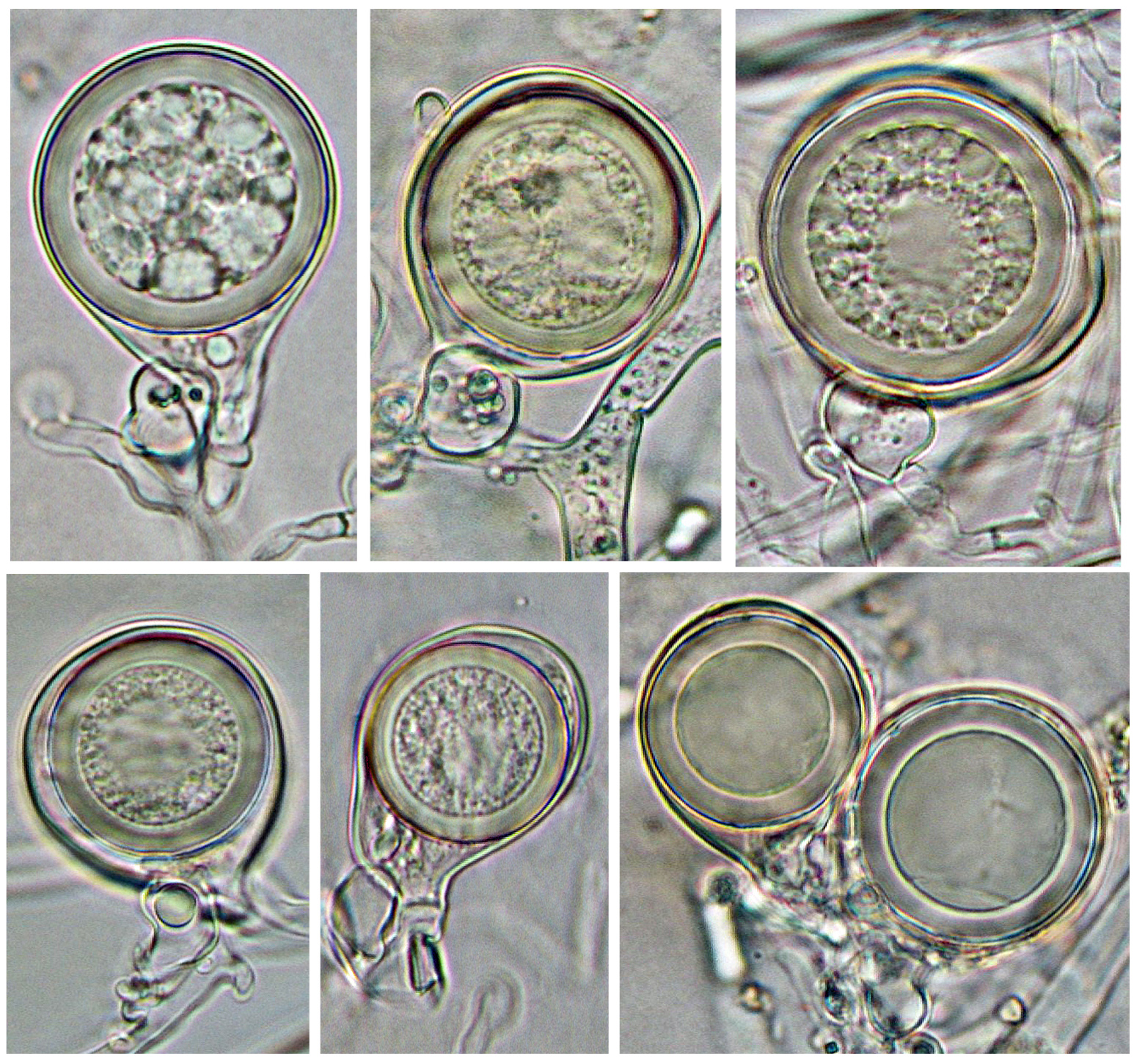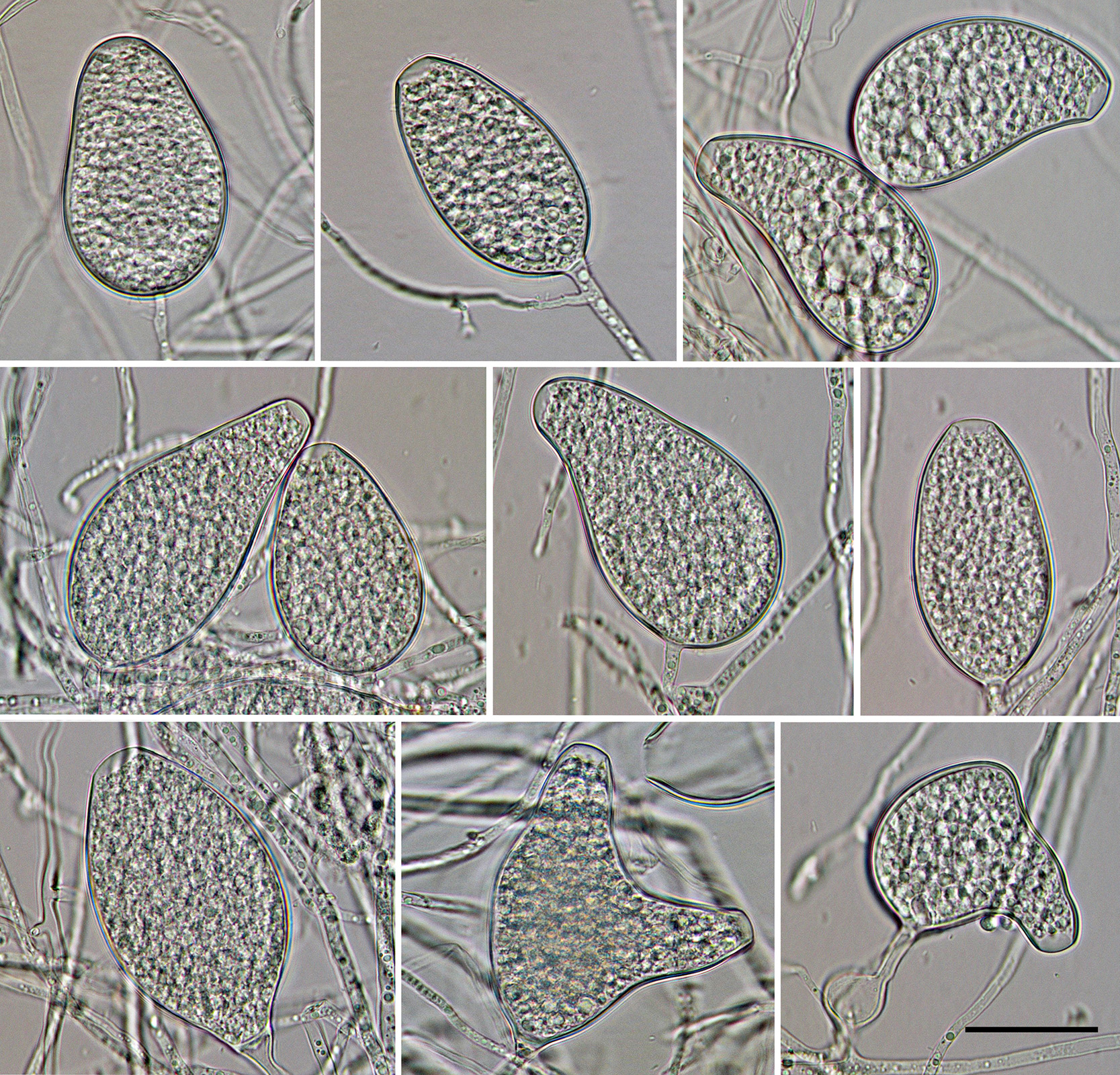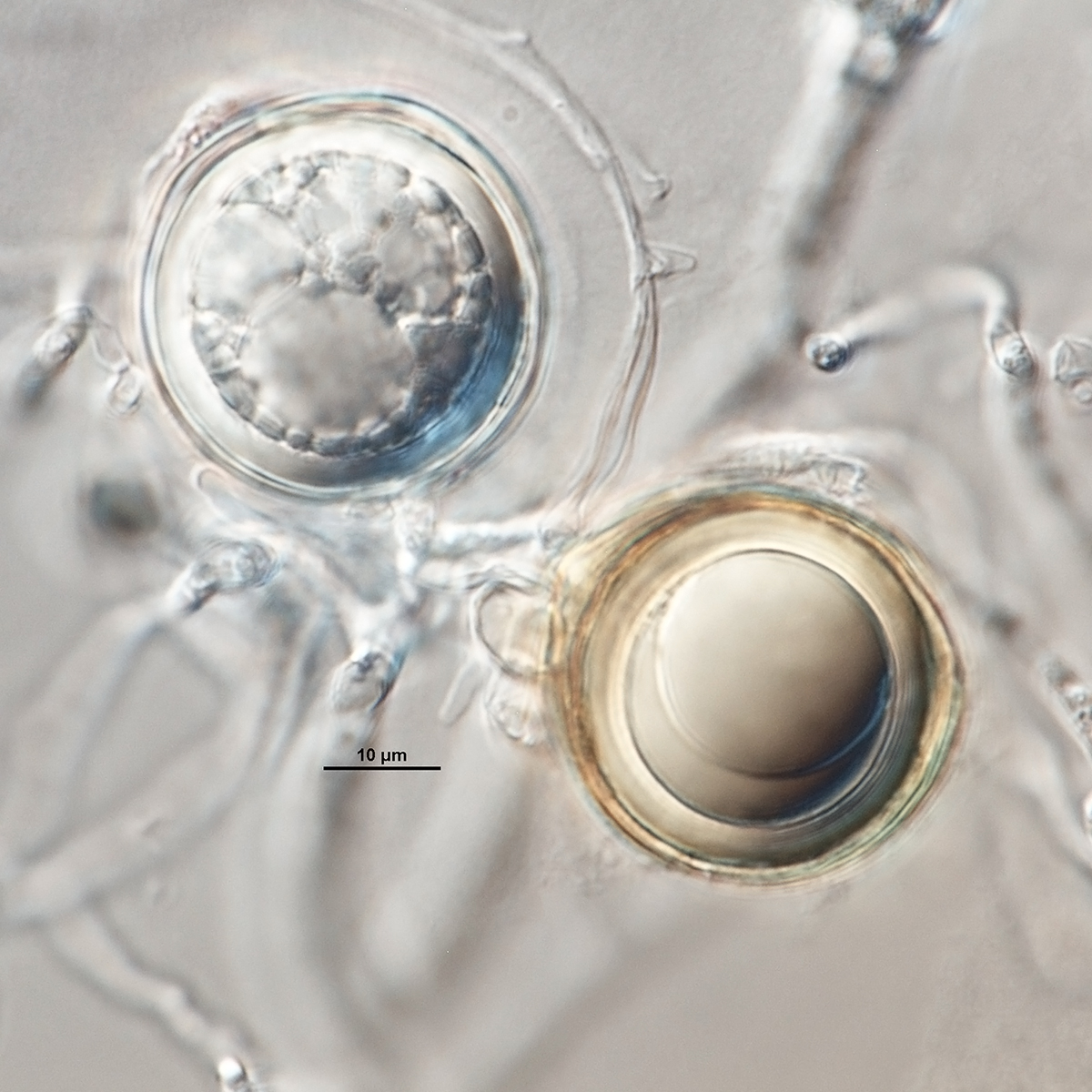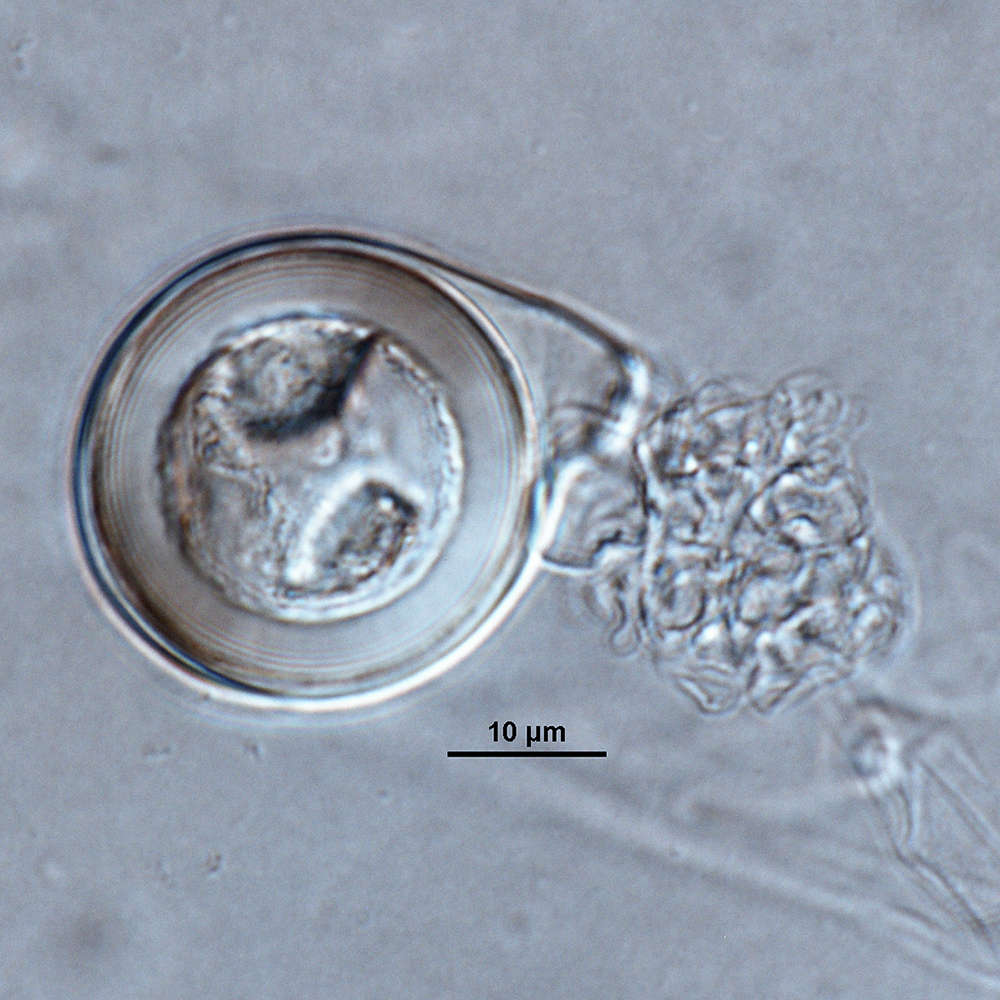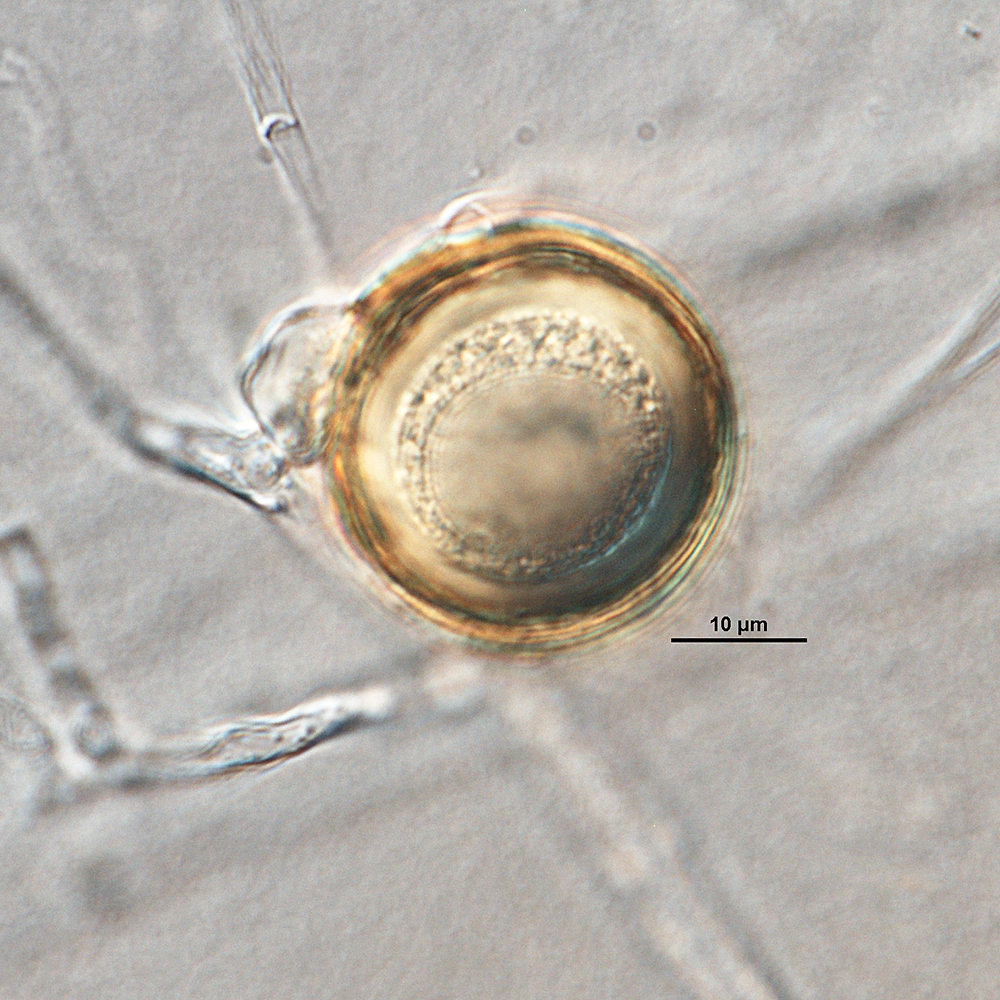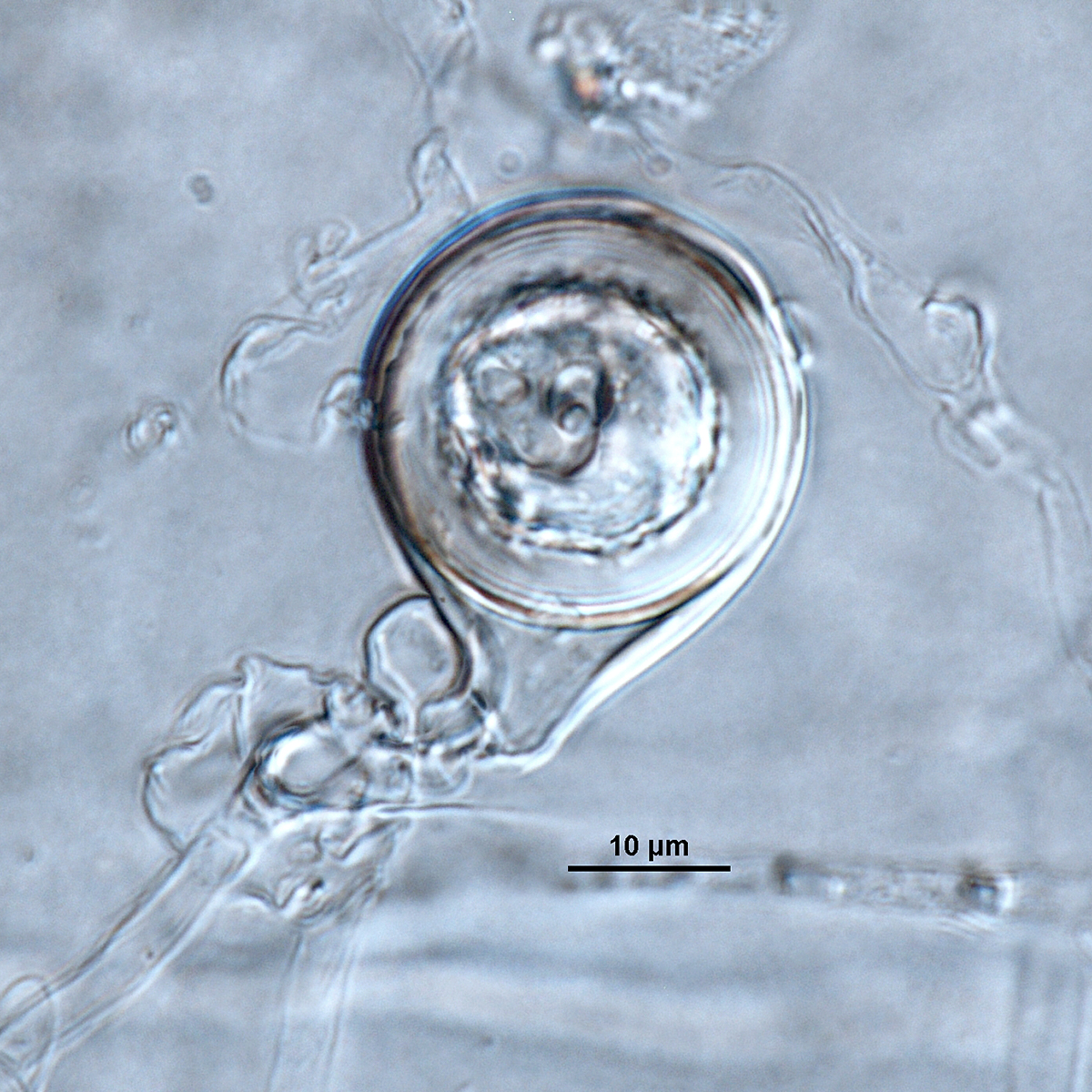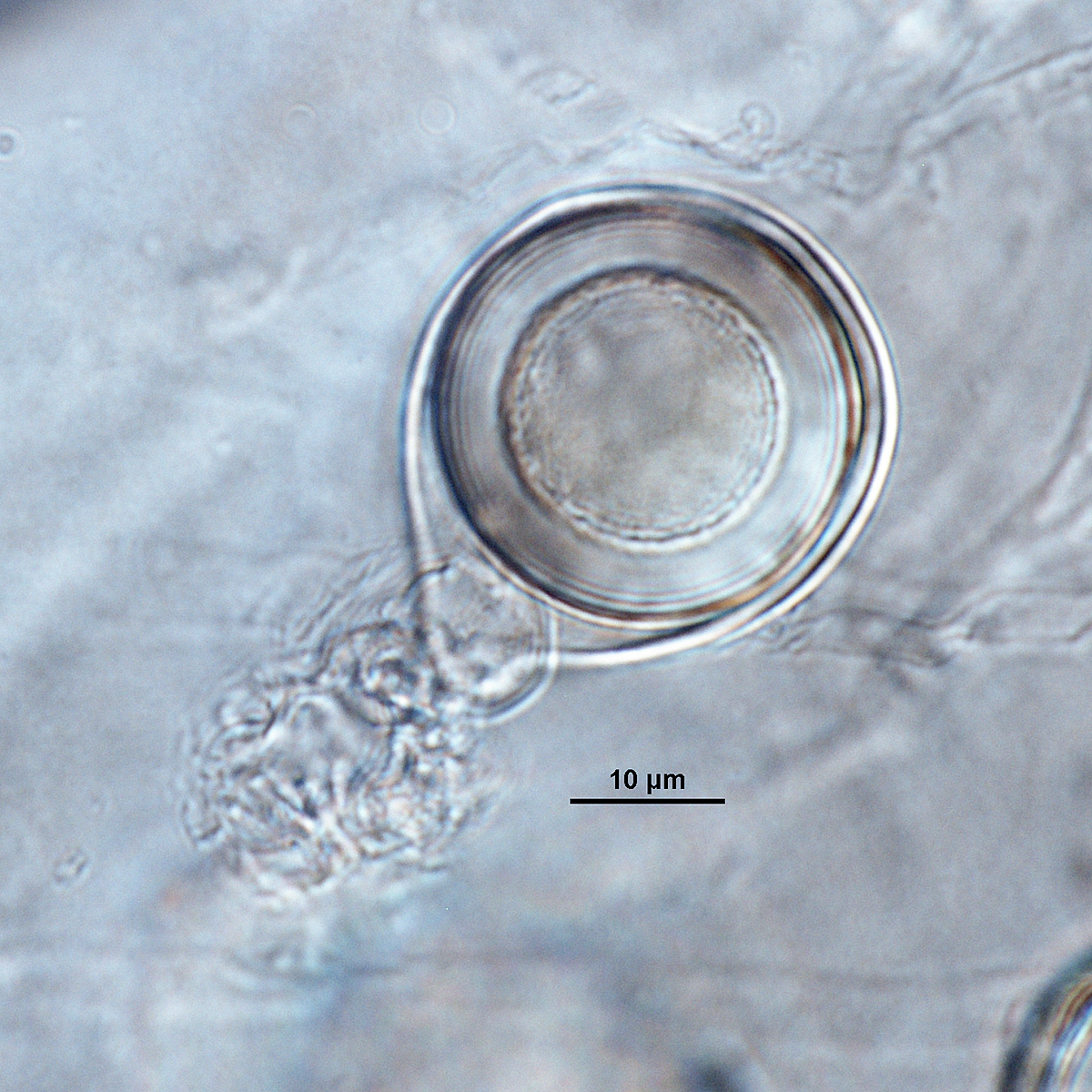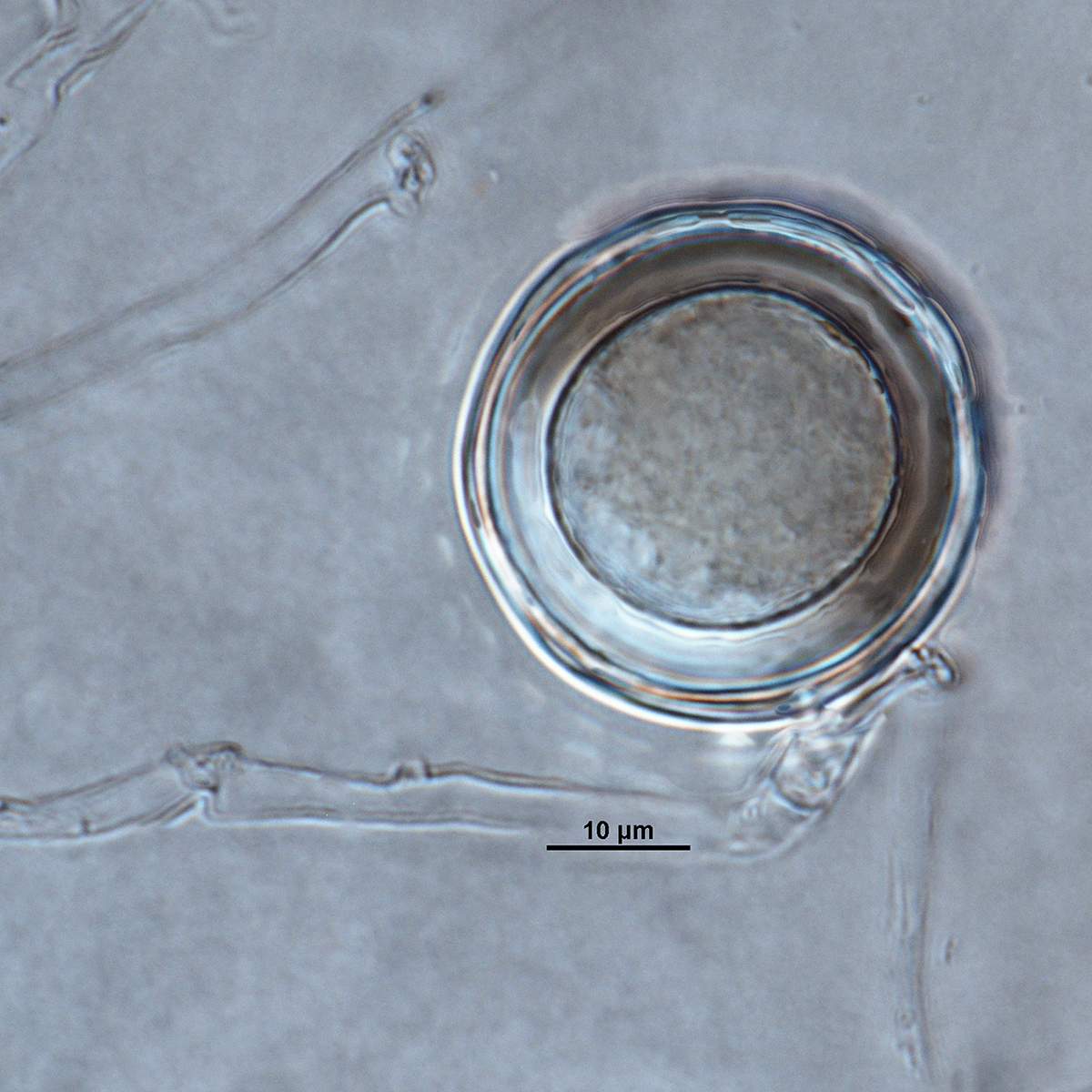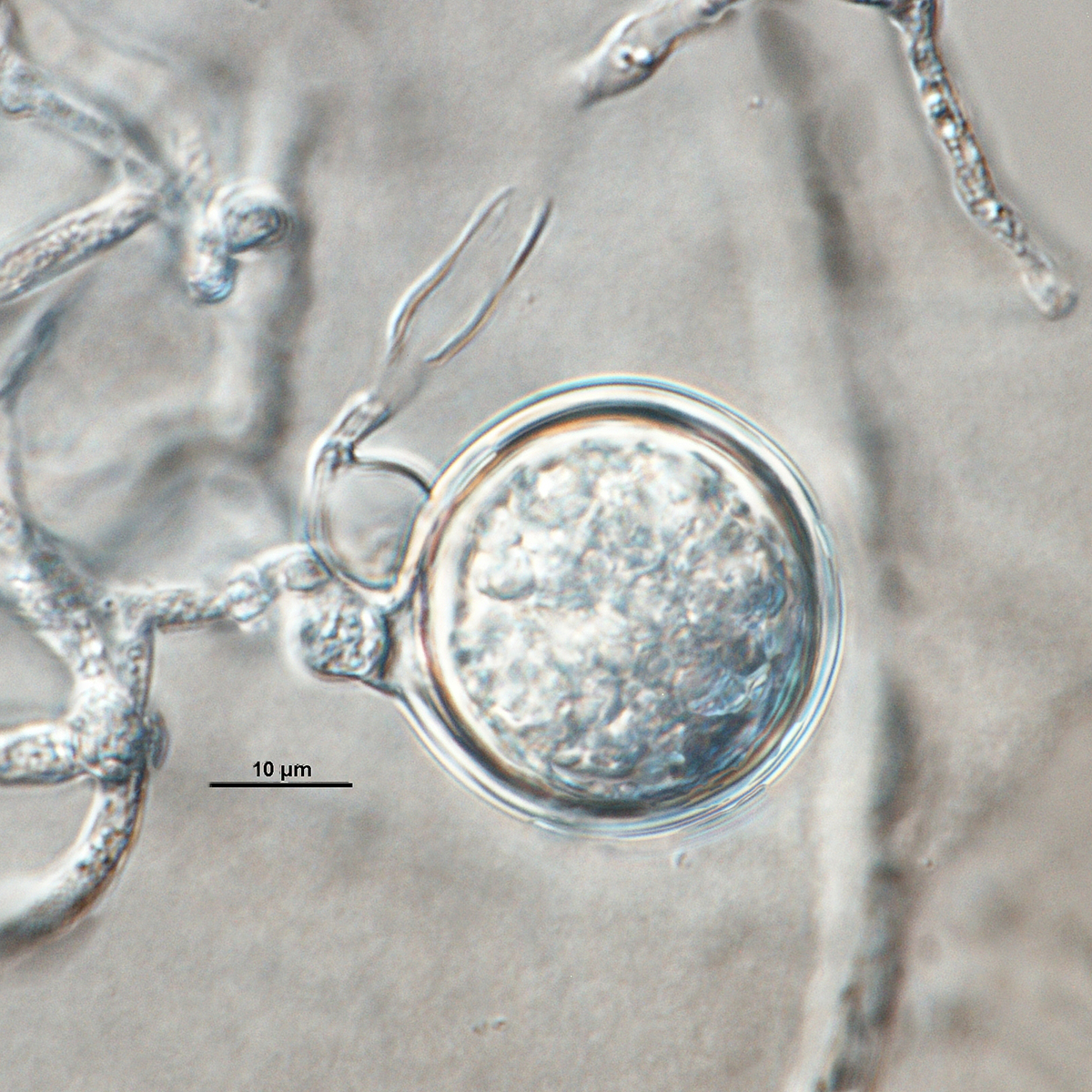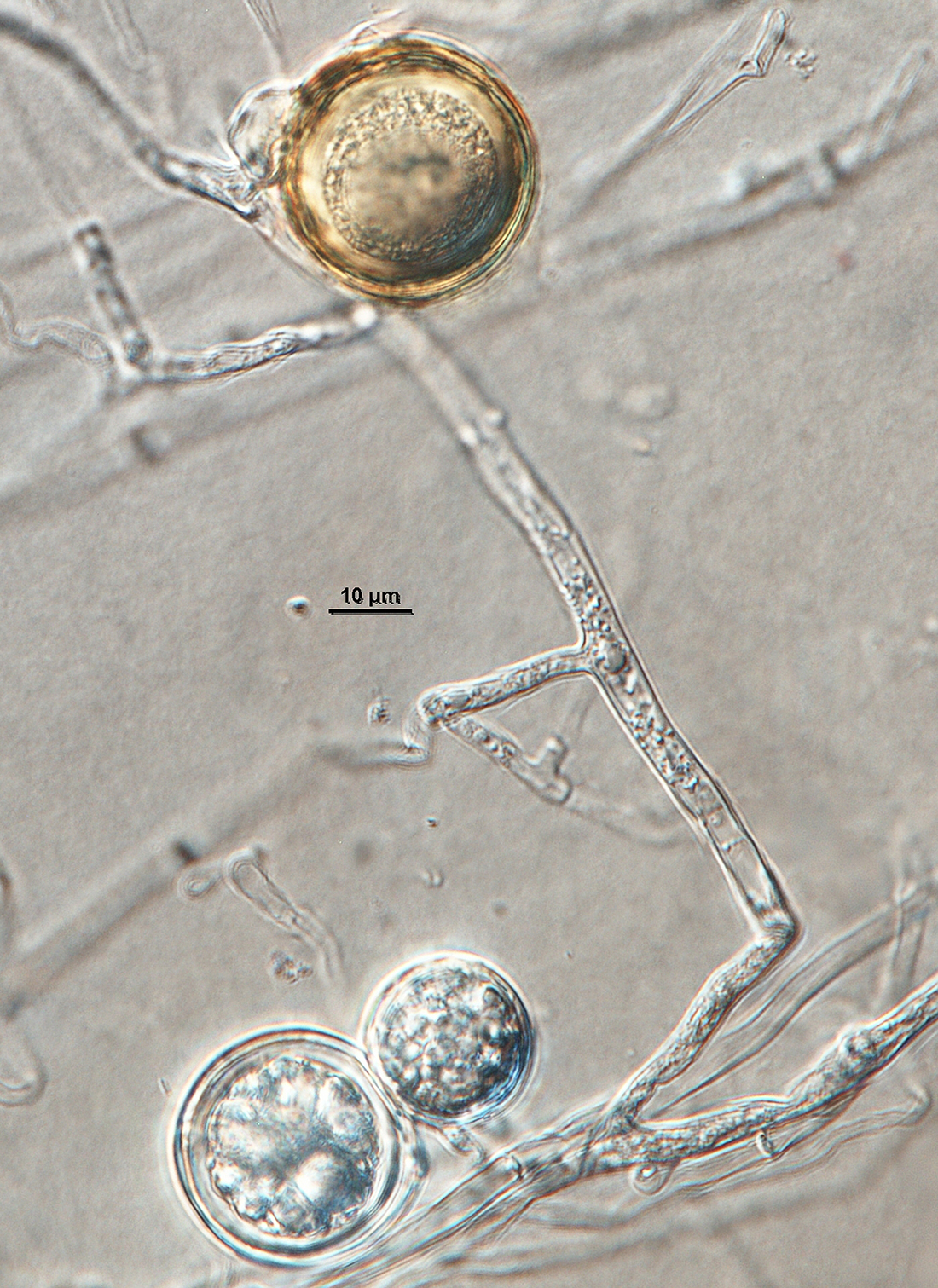Phytophthora pachypleura
|
Phytophthora spp. in subclade 2c: portion of the seven-loci ML phylogeny featuring the type cultures of 212 described species (by T. Bourret). Notice the position of P. pachypleura Ex-type CABI IMI502404 (AVA) = S&T BL 146. Gloria Abad, USDA S&T.
|
|
Phytophthora spp. in subclade 2c: Morphological Tabular key (PDF) and Tabular key legends (PDF) in IDphy2 KEY SECTION. Notice the data of P. pachypleura Ex-type CABI IMI502404 (AVA) = S&T BL 146. Gloria Abad, USDA S&T.
|
|
Phytophthora pachypleura (CPHST BL 146) colonies of the ex-type grown for 7 days on (a) V8® Agar, (b) potato dextrose agar, and (c) malt extract agar; photo by Krysta Jennings and Leandra Knight, USDA-APHIS-PPQ |
|
Phytophthora pachypleura (ex-type CPHST BL 146) sexual phase: (a–c) gold-brown oogonia with paragynous antheridia and plerotic oospores, (d–g) oogonia with tapered bases and paragynous antheridia; photos by Gloria Abad, USDA-APHIS-PPQ. |
|
Phytophthora pachypleura (ex-type, 1 BH-2013 strain RHS 53593.1) homothallic sexual phase: smooth-walled oogonia, with paragynous antheridia, sometimes with tapered bases. Oospores can be plerotic or aplerotic; photo by Beatrice Henricot, The Royal Horticultural Society. |
|
Phytophthora pachypleura (ex-type, 1 BH-2013 strain RHS 53593.1) asexual phase: semipapillate, sometimes bipapillate, persistent sporangia with distorted shapes and hyphal swellings in sporangiophores; photos by Beatrice Henricot, The Royal Horticultural Society. |
|
Phytophthora pachypleura (ex-type CPHST BL 146) sexual phase: (a) gold-brown oogonium with paragynous antheridia and plerotic oospore with ooplast, and young oogonium, (b) aplerotic oospore in smooth-walled oogonium with paragynous diclinous antheridium; photos by Gloria Abad, USDA-APHIS-PPQ. |
|
Phytophthora pachypleura (ex-type CPHST BL 146) sexual phase: gold-brown oogonium with paragynous antheridia and plerotic oospore with ooplast, and young oogonium; photo by Gloria Abad, USDA-APHIS-PPQ. |
|
Phytophthora pachypleura (ex-type CPHST BL 146) sexual phase: oogonium with tapered base and paragynous antheridium; photo by Gloria Abad, USDA-APHIS-PPQ. |
|
Phytophthora pachypleura (ex-type CPHST BL 146) sexual phase: gold-brown oogonium with paragynous antheridium and plerotic oospore; photo by Gloria Abad, USDA-APHIS-PPQ. |
|
Phytophthora pachypleura (ex-type CPHST BL 146) sexual phase: oogonium with tapered base and paragynous antheridium; photo by Gloria Abad, USDA-APHIS-PPQ. |
|
Phytophthora pachypleura (ex-type CPHST BL 146) sexual phase: oogonium with tapered base and paragynous antheridium; photo by Gloria Abad, USDA-APHIS-PPQ. |
|
Phytophthora pachypleura (ex-type CPHST BL 146) sexual phase: oogonium with tapered base and paragynous antheridium; photo by Gloria Abad, USDA-APHIS-PPQ. |
|
Phytophthora pachypleura (ex-type CPHST BL 146) sexual phase: oogonium with paragynous antheridium and plerotic oospore; photo by Gloria Abad, USDA-APHIS-PPQ. |
|
Phytophthora pachypleura (ex-type CPHST BL 146) sexual phase: aplerotic oospore in smooth-walled oogonium with paragynous diclinous antheridium; photo by Gloria Abad, USDA-APHIS-PPQ. |
|
Phytophthora pachypleura (ex-type CPHST BL 146) sexual phase: gold-brown oogonia with paragynous antheridia and plerotic oospores; photo by Gloria Abad, USDA-APHIS-PPQ. |
Name and publication
Phytophthora pachypleura Henricot, Pérez Sierra & T. Jung (2014)
Henricot B, Pérez Sierra A, and Jung T. 2014. Phytophthora pachypleura sp. nov., a new species causing root rot of Aucuba japonica and other ornamentals in the United Kingdom. Plant Pathology 63: 1095–1109.
Corresponding author: beatricehenricot@rhs.org.uk, beatrice.henricot@forestry.gsi.gov.uk
Nomenclature
from Henricot et al. (2014)
MycoBank
Fungal names
Etymology
refers to the thick wall of the oosporesoospores:
zygote or thick-walled spore that forms within the oogonium after fertilization by the antheridium; may be long-lived
(‘pachy’ = ‘thick’ and ‘pleura’ = ‘wall’ in Greek)
Typification
Type: UNITED KINGDOM, Cheshire, isolated from roots of Aucuba japonica, June 2008, B. Henricot; holotype IMI 502404 (preserved in a metabolically inactive state by deep-freezing in CABI, Egham, Surrey, UK)
Ex-type: culture IMI 502404
NOTE: Phytophthora pachypleura IMI 502404 not available at HerbIMI (1/28/2017)
Sequences for ex-type in original manuscript
Phytophthora sp. BH-2013 strain RHS 53593.1 = ITSrDNA KC855330, β-tub KC855354, TEF KC855378, Cox1 KC855426, NDH KC855402
Ex-type in other collections
(ET) CABI IMI502404 (AVA), WPC P19987, S&T BL 146 (Abad), 61H7 (Hong), TJ 0472 (Jung)
Molecular identification
Voucher sequences for barcoding genes (ITS rDNA and COI) of the ex-type (see Molecular protocols page)
Phytophthora pachypleura isolate CPHST BL 146 (= P19987 WPC) = ITS rDNA MG865558, COI MH136948
Voucher sequences for Molecular Toolbox with seven genes (ITS, β-tub, COI, EF1α, HSP90, L10, and YPT1
(see Molecular protocols page) (In Progress)
Voucher sequences for Metabarcoding High-throughput Sequencing (HTS) Technologies [Molecular Operational Taxonomic Unit (MOTU)]
(see Molecular protocols page) (In Progress)
Sequences with multiple genes for ex-type in other sources
- NCBI: Phytophthora pachypleura CPHST BL 146
- NCBI: Phytophthora sp. 1 BH-2013 strain RHS 53593.1
- EPPO-Q-bank: Phytophthora pachypleura
- BOLDSYSTEMS: Phytophthora pachypleura (barcoding COI & ITS)
Position in multigenic phylogeny with 7 genes (ITS, β-tub, COI, EF1α, HSP90, L10, and YPT1)
Clade 2c
Morphological identification
adapted from Henricot et al. (2014)
Colonies and cardinal temperatures
Colonies on V-8 agar, potato dextrose agar, and malt extract agar with chrysanthemum pattern. Minimum temperature for growth 5°C, optimum 25°C, maximum 35°C.
Conditions for growth and sporulation
Sporangia produced abundantly on non-sterile soil extract, and gametangiagametangia:
part of hypha specialized for fusion in sexual reproduction (see antheridium and oogonium)
readily produced on V8A within 7 days.
Asexual phase
Sporangia semipapillate, sometimes bipapillate; persistentpersistent:
pertaining to sporangia that remain attached to the sporangiophore and do not separate or detach easily (cf. caducous)
; ovoidovoid:
egg-shaped, with the widest part at the base of the sporangium and the narrow part at the apex
, ellipsoidellipsoid:
refers to a solid body that forms an ellipse in the longitudinal plane and a circle in cross section; many fungal spores are ellipsoidal or elliptic
, obpyriformobpyriform:
inversely pear-shaped, i.e. with the widest part at the point of attachment (cf. pyriform)
, limoniform, and with irregular or distorted shapes (mouse-shaped) (30–84 L x 22–44 W µm); showing external proliferationexternal proliferation:
formation of a sporangium after a sporangiophore has emerged from beneath and external to an empty sporangium that has previously emitted its zoospores (cf. internal proliferation)
close to the sporangial base resulting in loose sympodiasympodia:
a type of sporangiophore which appears simple, but where each successive sporangium develops on a branch behind and to one side of the previous apex, where growth has already ceased
or originated in unbranched sporangiophores. Hyphal swellings sometimes formed close to the sporangial base. ChlamydosporesChlamydospores:
an asexual spore with a thickened inner wall that is delimited from the mycelium by a septum; may be terminal or intercalary, and survives for long periods in soil
absent.
Sexual phase
Homothallic. OogoniaOogonia:
the female gametangium in which the oospore forms after fertilization by the antheridium
smooth-walled, globoseglobose:
having a rounded form resembling that of a sphere
to slightly subglobose (21–39 µm diam.), sometimes with tapering base; antheridiaantheridia:
the male gametangium; a multinucleate, swollen hyphal tip affixed firmly to the wall of the female gametangium (the oogonium)
paragynousparagynous:
pertaining to the sexual stage in which the antheridium is attached to the side of the oogonium (cf. amphigynous)
, obovoidobovoid:
inversely egg-shaped; ovoid, but with the widest part at the apex
, club-shaped, or irregular, usually attached close to the oogonial stalk and in some cases more than one antheridiumantheridium:
the male gametangium; a multinucleate, swollen hyphal tip affixed firmly to the wall of the female gametangium (the oogonium)
per oogoniumoogonium:
the female gametangium in which the oospore forms after fertilization by the antheridium
is observed; oosporesoospores:
zygote or thick-walled spore that forms within the oogonium after fertilization by the antheridium; may be long-lived
predominantly pleroticplerotic:
pertaining to an oospore that fills the oogonium (cf. aplerotic)
and sometimes slightly apleroticaplerotic:
pertaining to a mature oospore that does not fill the oogonium; i.e. there is room left between the oospore wall and oogonium wall (cf. plerotic)
(17–30 µm diam.); oosporesoospores:
zygote or thick-walled spore that forms within the oogonium after fertilization by the antheridium; may be long-lived
wall thick.
Additional specimen(s) evaluated
Phytophthora pachypleura ex-type CPHST BL 146, duplicate of P19987 (World Phytophthora Collection)
Hosts and distribution
Distribution: Europe (Italy, UK)
Substrate: roots
Disease note: root rot
Host: Aucuba japonica (Garryaceae)
Retrieved February 01, 2018 rom U.S. National Fungus Collections Nomenclature Database.
Additional references and links
- SMML USDA-ARS: Phytophthora pachypleura
- EPPO Global Database: Phytophthora pachypleura
- Forest Phytophthora of the world: Phytophthora pachypleura
- CABI Digital Library: Phytophthora pachypleura
- Encyclopedia of Life (EOL): Phytophthora pachypleura
- Index Fungorum (IF): Phytophthora pachypleura
- Google All Phytophthora pachypleura
- Google Images Phytophthora pachypleura
- Google Scholar Phytophthora pachypleura
Fact sheet author
Z. Gloria Abad, Ph.D., USDA-APHIS-PPQ-S&T Plant Pathogen Confirmatory Diagnostics Laboratory (PPCDL), United States of America.



